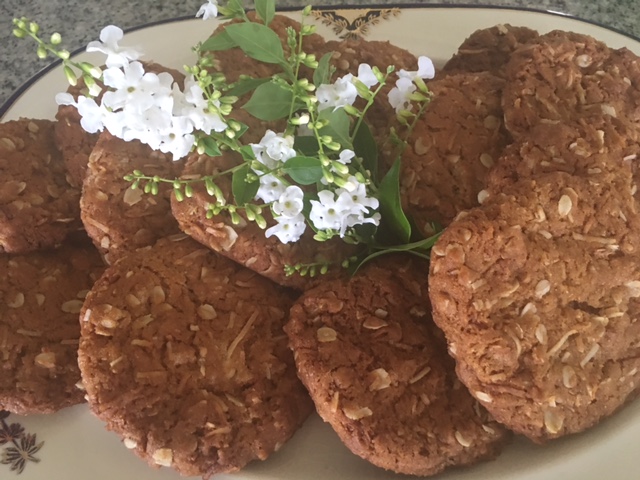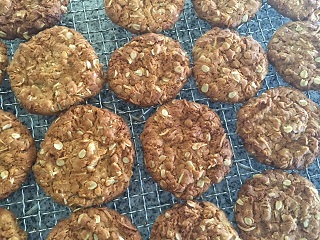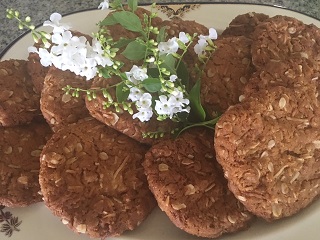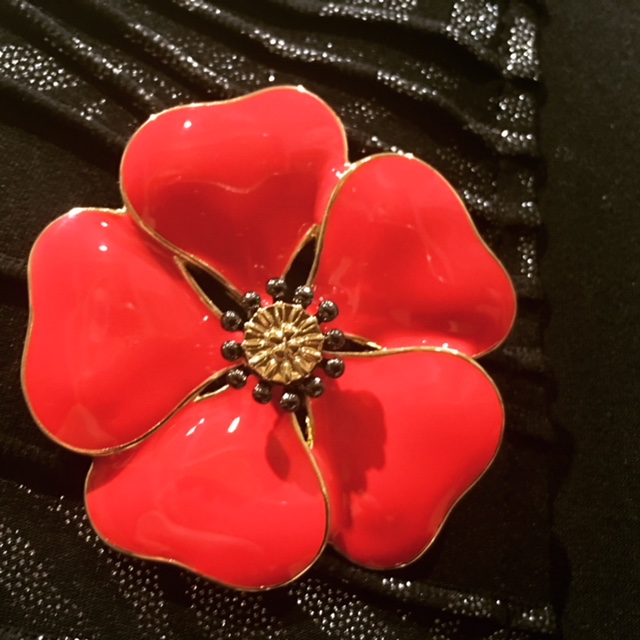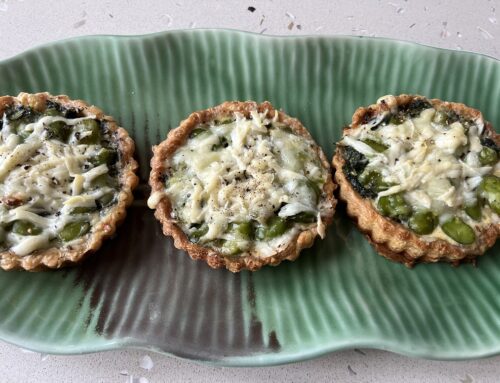I always enjoy baking these Anzac biscuits for Australia Day and Anzac Day. They are a quick, sweet, treat to make in about half an hour; they provide a wonderful activity to bake with your children and are always a special favourite.
Anzacs are oat-based chewy, sturdy biscuits, said to have been first created by the wives and girlfriends of the soldiers in World War 1, to send over to their loved ones to supplement their meagre army rations. My story of the Anzac Biscuit is continued after the recipe.
Whenever I share this recipe, I receive enthusiastic feedback from happy cooks, so I hope you enjoy baking them too. Traditionally these ‘historic’ biscuits are served as rounded mounds, a modern alternative is to roll the mixture into a log, cut into slices and cook.
125g butter
1 tbsp golden syrup
2 tbsp boiling water
1 tsp bicarbonate soda
150g flour
220g sugar
100g rolled oats
90g desiccated coconut
Preheat the oven to 150ºC. Melt butter and golden syrup over gentle heat. Mix boiling water and bicarbonate soda and add to the pot.
Mix together the oats, coconut, sifted flour and sugar. Pour the buttery, golden syrup mixture onto the dry ingredients and blend well.
Drop teaspoons of the mixture onto a prepared oven tray, with the appropriate distance apart to allow for the biscuit to spread as it cooks.
Cook in a slow 150ºC oven for 20 minutes. Cool on the tray for a few minutes and then move to a wire cake rack. When cold store in an airtight container.
- Anzacs hot from the oven
- Anzacs ready to eat!
- Anzac Day remembrance
- Red poppy brooch from the Australian War memorial
The first Anzac biscuits did not contain all the yummy ingredients ours do today. The biscuits needed to travel and keep well for several months on their journey from Australia to the ANZAC – Australian and New Zealand Army Corps in Gallipoli and the Western Front. They were traditionally hard tack biscuits, a bread substitute that had a long shelf life. No eggs were used as eggs were scarce and milk was omitted to increase the long life of the biscuit; golden syrup was used to bind the dry ingredients together. Even so, they were a great hit with the troops, and continued to be baked well after the war, when they started to appear in many cookbooks. They have continued to be associated with ANZACS and hence their name!
Exactly when these sweet, eggless, rolled oat–based biscuits came to be called ‘Anzac’ is unclear, but most sources agree that they evolved around the time around the first World War. According to Australian culinary historian, Allison Reynolds, author of ‘Anzac Biscuits: The Power and Spirit of an Everyday National Icon’, (2018), says that various types of similar biscuits existed before the war and initially came to be known as Soldier’s Biscuits or Red Cross Biscuits, when wives and women’s groups started posting them to soldiers overseas as ‘sweet relief treat’ for the troops of the Australian ands New Zealand Army Corps. Reynolds writes that after 1915, when troops from the Australian and New Zealand Army Corps, ANZAC, stormed the Gallipoli peninsula, these homemade provisions were dubbed ‘Anzac biscuits’. However, Reynolds guesses that versions more closely resembling contemporary Anzac “bikkies” laced with oats, golden syrup, and coconut
probably didn’t emerge until a bit later, around 1920.
The iconic status of these cherished biscuits, can be seen by consulting the regulations outlined by the Protection of the Word “Anzac” Act 1920. Issued by the Australian government’s Department of Veterans’ Affairs. The law states that any biscuits bearing the name ‘Anzac’, must “generally conform to the traditional recipe and shape” and must never be referred to as “Anzac cookies.”
The first recorded mention of them in a cookbook appears to be in 1923 in Mrs. H Wharton-Shaw’s ‘Six hundred tested recipes’ using the oats, sugar, flour, butter and golden syrup. These days they are made with rolled oats, flour, desiccated coconut, sugar, butter, golden syrup and baking soda.
Now, like the pavlova, there has been much discussion and contention about who first published the recipe – Australia or New Zealand! However, they are now immortalised and used as fundraisers for the RSL and are an integral part of our ANZAC day celebrations.
I have tried out various recipes and now have quite a collection of them. However, these days I always make the recipe from my grandmother. The various recipes are all basically the same, with just slight differences – one might use honey instead of the golden syrup, one has lemon zest, some have nuts; some are crunchier, some chewier and nuttier.
Whatever the variations of ANZAC biscuits are, the basic ingredients are always oats, flour, butter and sugar, with the butter melted and mixed with the dry ingredients.
These basic biscuit ingredients of butter, sugar and flour, can produce amazingly different results depending on the method of mixing. For instance, shortbread requires the butter to be rubbed into the flour; for chocolate chip biscuits the butter and sugar are creamed together first.
For Anzac biscuits, it is the melt and mix method, a method used for a variety of different style of biscuits, such as tuilles, brandy snaps, Florentines and langue du chats.
It is important to mix the ingredients together well so that the sugar is completely dissolved, but over-mixing must be avoided. Over-mixing can make the biscuit tough and hard; my aim is for crunchy. Over-mixing overdevelops the gluten in the flour and causes a tough, chewy biscuit and can causes shrinkage as well.
Be sure not to place the biscuit mixture too close together on the oven tray, as the biscuits spread a lot during the cooking and can end up with them all joined together into a biscuit slice.
Traditionally these ‘historic’ biscuits are served as rounded mounds, a modern alternative is to roll the mixture into a log, cut into slices and cook.
By varying the quantities slightly, you can achieve the result you prefer:
If you like your Anzacs crisp, use a higher sugar content to that of the golden syrup, use less liquid and bake in a low, slow oven.
If you like them soft and chewy, use a higher proportion of golden syrup and use less bicarbonate soda which will reduce any metallic taste.
If you find your mixture is too much for your requirements, roll it into a log shape, wrap in cling wrap and freeze for another time.
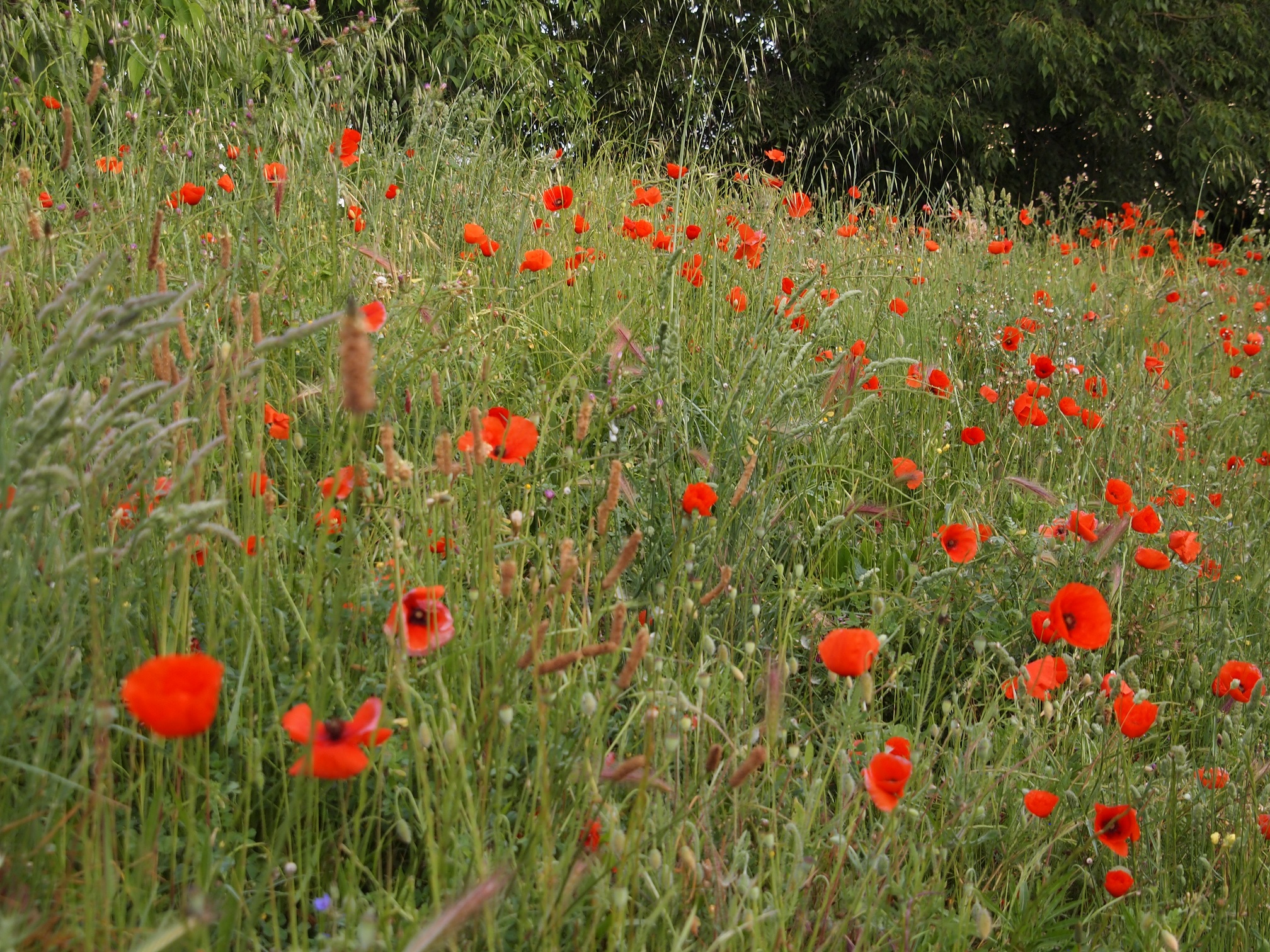
Fields of poppies in northern France

